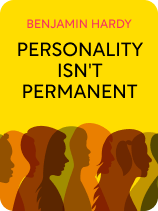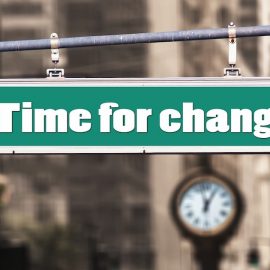

This article is an excerpt from the Shortform book guide to "Personality Isn't Permanent" by Benjamin Hardy. Shortform has the world's best summaries and analyses of books you should be reading.
Like this article? Sign up for a free trial here.
What is Benjamin Hardy’s book Personality Isn’t Permanent about? What is the key message to take away from the book?
In his book Personality Isn’t Permanent, organizational psychologist and entrepreneurial speaker Benjamin Hardy argues that, while most people see personality as fixed and essential to who they are, this is false and unhealthy. In reality, he explains, personality is highly changeable—and with the right approach, you can become whoever you want to be.
Below is a brief overview of Personality Isn’t Permanent: Break Free From Self-Limiting Beliefs and Rewrite Your Story by Benjamin Hardy.
Personality Isn’t Permanent: Break Free From Self-Limiting Beliefs and Rewrite Your Story
While most people think of personality as fixed, Benjamin Hardy argues that it’s actually fluid and changeable. In his book Personality Isn’t Permanent, Hardy attempts to show the downsides of seeing personality as fixed and to teach you how to change yourself to be whomever you want.
Hardy is an organizational psychologist, entrepreneur, speaker, and author of several books and a popular blog. While he primarily focuses on entrepreneurship and leadership, Personality Isn’t Permanent is written for a general audience interested in improving their lives.
In this guide, we’ll cover Hardy’s ideas in five parts:
Part 1: Clearing Up Misconceptions About Personality clarifies common misconceptions people have about personality and explains what the science actually says—that you can change your personality.
Part 2: Personality Change Starts With Deciding Who You Want to Become discusses Hardy’s core strategy for personality change—choosing an optimal self to become and setting a single primary goal to help you achieve this self..
Part 3: Take Action Toward Your Primary Goal explores how changing your behavior and lifestyle can help you accomplish your primary goal and become your optimal self.
Part 4: Change Your Narratives to Serve Your Primary Goal discusses how the narratives you tell yourself about who you are dictate what you’re capable of and how to change unhealthy narratives that get in your way.
Part 5: There Is No Endpoint talks about the lifelong process of changing your personality and how you can avoid the pitfall of complacency.
Our commentary will build on and clarify Hardy’s ideas by exploring similar perspectives of other personal growth authors. Additionally, we’ll explore some nuanced advice from other writers with slightly different perspectives.
Part 1: Clearing Up Misconceptions About Personality
According to Hardy, most people think of their personality—that is, the totality of their abilities, preferences, and temperaments—as something innate and unchanging. This is exemplified by the popularity of personality tests (such as the Enneagram and the Myers-Briggs Type Indicator) which neatly categorize people into specific personality types. These tests are so popular, Hardy suggests, because people like to make sense of themselves—the tests give them metrics by which to define who they are.
Two Widely-Held Misconceptions About Personality
Hardy contends that thinking about personality as a fixed feature comes largely from multiple misconceptions about how personality works. We’ve synthesized his ideas into two main misconceptions.
Misconception #1: The Past Determines Your Personality
The first misconception is that people think the past determines their personality. They succumb to the “end of history illusion,” the idea that everything that’s happened so far in their lives has shaped them into who they are today, but that their current self won’t change much going forward and won’t be shaped as much by future life events. As a result, they believe the past has the final word on who they are today. For instance, someone who always struggled with social confidence in the past might think that they are simply not a confident person: It’s just not in their DNA.
Misconception #2: Who You Are Right Now Is Who You Really Are
The second misconception is that people think that who they are right now is their true, authentic self—that their current abilities, preferences, and temperaments define who they are at their core. Because our society teaches that being authentic is a good thing, Hardy explains, people who think that their current self is their authentic self often think this means they shouldn’t try to change any of their current traits—they should leave their personality as is.
The Idea of a Fixed Personality Limits What You Can Achieve
Hardy argues that these misconceptions—that you’re the fixed product of your past and that the way you are right now is who you really are—foster a major self-limiting belief: Change isn’t an option. As a result, you limit your life significantly: You choose jobs, relationships, and activities that you already do and aren’t outside your comfort zone. You believe that whatever feels uncomfortable or challenging to who you are now must not be for you, and you miss out on harder but more rewarding things.
In practice, this looks like settling for a lesser position at work because the one you’d rather have is daunting, or giving up on a new hobby because it wasn’t immediately enjoyable.
Personality Change Is Possible
According to Hardy, science shows that your personality is not fixed and that you can change it—studies consistently demonstrate that personality traits change over the course of your life. While he contends that your past influences your personality, it doesn’t fully determine it.
In reality, your personality is largely determined by the life you live. In other words, your culture, goals, environment, job, habits, and social roles all play a part in shaping your personality. This means that as your life—the decisions you make, behaviors you engage in, and people and places you surround yourself with—changes, your personality does too. This is all good news: It means you can change the things you want to change about yourself. You aren’t stuck within the limitations of your current personality.
In the rest of this guide, we’ll discuss how you can change your personality by first identifying your optimal self and the steps necessary to becoming this person. We’ll then discuss how to change your behaviors to help you reach this goal and explore the empowering effect of changing your unhealthy narratives about yourself.
Part 2: Personality Change Starts With Deciding Who You Want to Become
According to Hardy, because your thoughts and actions largely determine your personality, you can change your personality by changing the way you live. As we discussed, most people cater to their limitations and structure their lives based on their current personality—but by acting and thinking the way they’re used to, they live a life that maintains their existing personality.
Instead, you’ll want to envision your optimal self and structure your life around this vision—thinking and acting in ways that will help you become more like them. Eventually, you’ll be the person you want to be, living the life you want to live.
However, Hardy notes, changing the way you live your life based only on a vision of a better future is unlikely to be as successful. He argues that you’ll also need a clear framework to guide your thoughts and actions if you want to make significant changes to yourself. In this section, we’ll discuss why Hardy believes that a clear framework for change makes it easier to succeed, his argument that a single primary goal is the best framework for change, and what things to consider when choosing a single primary goal.
Choose a Single Primary Goal
If you try changing your personality based only on a vague vision of a better future, you’ll struggle more than necessary. Without a clear direction, you won’t feel sure about what you should change or how. A better strategy, Hardy suggests, is choosing a single primary goal to work toward. This goal should be one that will help you become your optimal self so that making progress on your clear goal equals making progress on the more vague process of changing into the person you want to be.
Why You Should Choose Just One Primary Goal
It might seem counterintuitive and inefficient to focus on one primary goal instead of several—since changing your personality requires changing many things about yourself. Why choose just one? Hardy argues that choosing one primary goal has two benefits: It’s easier to focus on, and it helps you make progress on other goals as well.
Benefit #1: One Goal Is Easier to Focus On
Hardy explains that having just one goal simplifies your pursuit of your optimal self because you can make all your decisions through a simple lens: Weigh each decision in your life based on whether it helps or hinders you in reaching your goal.
As a result, you have a much clearer idea of what you should do and why than if you were to juggle multiple primary goals or decide what changes or improvements will be “best” without guidelines.
Benefit #2: Progress on One Primary Goal Leads to Progress on Other Goals
Additionally, Hardy asserts that choosing a single main goal doesn’t mean you have to sacrifice making progress on other goals. The progress you make and the confidence you earn in one area of your life, he says, will spill over into other areas. This is largely because making progress on your primary goal gives you a feeling of momentum that makes it easier and more rewarding to do hard, uncomfortable things across the board.
Additionally, in your pursuit of your primary goal, you’ll end up making—and meeting—all kinds of supporting “secondary goals” along the way.
For instance, imagine you’ve been working towards your primary goal of getting a promotion at work. To support this goal, you create the secondary goal of getting in shape because doing so will give you more energy to work hard and earn that promotion. Going to the gym will help you progress toward your primary goal of promotion, making you feel excited to make even more progress. As a result, you’ll find it much easier to make a habit of going to the gym.
Two Important Considerations When Choosing a Primary Goal
Hardy argues that it’s important to make two considerations when choosing a primary goal: It should require you to change your personality in the ways you want, and you should commit yourself to completing the goal at any cost.
Consideration #1: Choose a Primary Goal That Requires You to Become Your Optimal Self
Hardy says that your primary goal should be one that requires you to change your personality into the one you want. While a goal that you could accomplish without becoming your optimal self will still help you grow in some ways, a goal you cannot meet without becoming your optimal self is more likely to produce the kind of change you want.
Let’s say you want to become a kinder, more balanced, and loving listener. An example of a single primary goal to turn you into this person is becoming a therapist. Because you can’t be an effective therapist without these qualities, you’ll have to become the person you want to be to meet your goal.
Consideration #2: Commit to Completing Your Goal at Any Cost
Hardy instructs that in addition to choosing your primary goal, you also need to commit to completing the goal, not just trying to. He asserts that everyone has the power to meet their goals—whether or not you’ve met your goal is only the result of whether you’ve tried hard enough. He says that there are no obstacles that are too big for you if you’re willing to do whatever it takes.
If you only commit to trying, you acknowledge that if the going gets too tough, you’ll give up. Committing to completing the goal, on the other hand, means that failure is not an option and that you’ll do whatever it takes to succeed. This, Hardy argues, is the only guaranteed way to meet your goal.
Part 3: Take Action Toward Your Primary Goal
Now that you’ve thought about your optimal personality and a goal that will get you there, the next step is to begin working toward your primary goal. This involves both aligning your behaviors and decisions with your goal and changing the limiting ways you think about yourself. In this section, we’ll discuss how to choose behaviors and make decisions in service of your goal.
Why You Should Base Your Behaviors and Decisions on Your Primary Goal
Hardy says that to meet your primary goal, you’ll need to structure your everyday behaviors and your broader life decisions around it. As we discussed earlier, most people structure their lives around their current personality—listening to their impulses, doing things that feel agreeable, and ultimately, not changing. Structuring your life around who you want to be instead of who you are breaks you out of this cycle and pushes you toward change.
Living in service of your primary goal involves being intentional rather than impulsive. Instead of doing things that feel automatic and good in the moment—but don’t help you reach your primary goal—choose things that are harder in the short term but pay off in the long run.
On a smaller scale, this involves choosing behaviors that are consistent with your primary goal. For instance, you might choose leisure activities that replenish you and leave you energized to keep making progress instead of things that merely stimulate you and leave you feeling drained. On a larger scale, this involves basing your broader life commitments on your primary goal. For example, you might choose a job that pushes your comfort zone but helps you develop skills that will help you reach your goal.
Strategies for Making Goal-Oriented Decisions
Hardy offers a few strategies to help you make better decisions and use your time more intentionally. These include the following five strategies:
1) Go to Bed and Wake Up Earlier
If you wake up earlier than usual, Hardy says, you can use the extra time in the morning to work toward your goals. Since making progress gives you a sense of momentum, doing so first thing in the morning will help you feel motivated for the rest of your day.
At the other end of the day, if you commit to going to bed earlier, you’ll have less free time in the evening. This will pressure you to use your downtime for more restorative and rewarding things like spending time with family rather than watching a mindless TV show.
2) Surround Yourself With Reminders of Your Goals
Hardy also advocates that having small, frequent reminders of your optimal future in your environment helps you stay focused on your primary goal This translates to more motivation and self-control. Thus, it makes it easier to continue living your new lifestyle and prevents you from lapsing into unhealthy habits. A reminder could be a certain book that’s always on your nightstand or getting a tattoo related to a commitment you’ve made.
3) Limit Access to Temptations and Distractions
The more accessible temptations are, the easier it is to give in to them. Therefore, Hardy says that increasing the difficulty of seeking out temptations—things that would distract or impede you from meeting your goal—helps you resist them. For example, if you’re trying to eat healthily, not keeping unhealthy food in the house makes it a lot harder to cave to temptation—doing so would require a whole trip to the store.
Additionally, limit reminders of temptations so that you think about—and therefore give in to—them less. For instance, if you’re trying to use your time more intentionally, turning off notifications on your social media means you won’t be constantly reminded of this potential distraction and will thus be less likely to indulge in mindless scrolling.
4) Journal Intentionally to Change How You Think
Hardy recommends regularly writing about your goals and optimal future as a way to keep yourself in touch with your ideals and your vision for the future. Not only does it remind you of your commitments, but it also can be a helpful way to process information and change the way you think about your life and yourself.
By setting aside time to intentionally write and think about things from a more intentional perspective than your habitual one, you practice and get better at new ways of thinking. For example, journaling as your future self can help you learn how to think more like them, and journaling about things you’re grateful for can increase your overall gratitude in life.
5) Use Pressure Strategically
Hardy argues that increased pressure to complete your goals helps you build motivation and become more flexible and creative in the way you overcome obstacles. By strategically subjecting yourself to increased pressure, you can force yourself to quickly meet goals that you would otherwise never achieve or that would take a much longer time. One way of increasing feelings of pressure is by putting yourself under strict time constraints (like telling your boss you’ll have an important project completed by a challenging deadline). Another way to do this is by putting yourself under financial constraints (like having a friend hold onto a large sum of money that you don’t get back until you complete a goal).
Part 4: Change Your Narratives to Serve Your Primary Goal
Now that you know how to structure your life around your primary goal, you’ll now focus on changing your thoughts that stand in the way of your goal and becoming your optimal self.
The unhealthy ideas that your personality is fixed or that you’re determined by your past come from narratives—or stories—you tell yourself about who you are and the events that happen to you. The narratives you tell yourself can either help you or hinder you in reaching your goal. In this section, we’ll discuss how unhelpful narratives are formed, why they hinder your progress, how trauma—the most destructive kind of narrative—works and limits your ability to grow, and how to heal your narratives and traumas.
How Narratives Are Formed
Most people think they see the world objectively. However, Hardy says this is untrue. Your memories and everyday perceptions are not just the objective things you observe: They’re the objective observations plus the narratives you tell yourself about them. When something significant happens, you consciously or unconsciously form an explanation for why it happened and what that means about you and the world around you.
For instance, if you got into a car accident while texting, you would perceive the objective facts—you were texting and driving, and got into an accident—and you would tell yourself a story about what happened and what it means. In this example, your narrative might be that you got into the accident because you were texting while driving, that you have a bad habit of distracted driving, and that this means that you’re an irresponsible person.
Unhealthy Narratives Limit What You Can Achieve
Your narratives have the power to shape how you see and feel about yourself as a person. Sometimes you’ll tell yourself unhealthy narratives about your life—narratives that frame you in an unnecessarily negative light or as incapable of overcoming an event. By doing this, you decrease your confidence, which gets in the way of meeting your primary goals in two distinct ways.
First, people often tell themselves narratives that frame them as being powerless victims of a thing that happened and therefore unable to do anything about it. At a day-to-day level, this looks like seeing inconveniences as a bigger deal than they need to be. An example is sleeping through your alarm and telling yourself that this means you’re going to fall behind on your work and have a bad day. At a more significant level, someone who grew up with an absent parent might tell themself that their current problems are the parent’s fault and that they can’t do anything about it.
Second, people also often see an event as proof that their limitations are fundamental to them and unchangeable. For instance, someone who tries speaking up in a social setting and gets spoken over might interpret this as proof that they simply aren’t capable of being assertive.
The Most Limiting Kind of Narrative: Traumatic Narratives
Hardy argues that the most limiting kind of unhealthy narratives people tell themselves are around traumas. When most people think of trauma, they think of horrific events that cause PTSD. However, Hardy explains that you can also think of trauma as any negative event that leads to lasting fear, shame, and unhealthy narratives about yourself. By this definition, everyone has trauma.
How Trauma Works
So how does trauma work? Hardy claims that when an event is frightening or emotionally painful enough, sometimes a person unconsciously develops a deeply entrenched, unhealthy narrative about it. For instance, if you asked someone out as a kid, and they laughed at you, you might develop a deep belief that you’re an unappealing person to date.
The traumatic narrative serves a defensive purpose: to prevent you from feeling similar types of pain in the future by encouraging you to avoid similar situations. If you develop negative beliefs about yourself after an emotionally painful experience, you’ll be more likely to avoid similar kinds of experiences that could make you feel the same type of emotional pain. Building on the last example, if you believe you’re unappealing to date, you’re much less likely to try expressing romantic interest to anybody and risk further rejection.
While these negative narratives and beliefs help you avoid short-term discomfort, they lead you to see yourself as less capable and ashamed of yourself. Unresolved traumas—or events that you still carry unhealthy narratives about—make you feel defined by your past and incapable of changing your personality.
According to Hardy, unresolved trauma can also prevent you from doing things necessary for meeting your primary goal. For instance, if your primary goal is to become a CEO, but you have a traumatic memory that makes you doubt your competence as a leader, you might avoid putting yourself in leadership positions. Additionally, negative attitudes toward yourself from unresolved trauma lower your self-esteem and confidence in general, both of which are necessary ingredients for feeling empowered and motivated enough to complete your primary goal.
Heal Yourself by Changing Unhealthy Narratives
Fortunately, Hardy says you can change your unhealthy narratives so they don’t block you from meeting your primary goal and becoming your optimal self. To do this, reshape your narratives to be in service of your future goal, choosing narratives that frame you in a positive light and as empowered.
We’ve synthesized Hardy’s advice on how to change your general unhealthy narratives into four main strategies: identify with your future self, focus on the positives, consider more of the context, and—specifically for healing traumatic narratives—share your trauma.
1) Identify With Your Future Self
Rather than thinking about yourself as the person who has your current limitations, think of yourself as the person who’s going to overcome these limitations—defining yourself based on who you will be, not who you’ve been. For instance, instead of thinking of yourself as someone who’s not confident and never has been, think of yourself as someone who will be confident in the near future. By identifying more with your future self than your current limitations, you see your limitations as temporary—and therefore feel empowered to overcome them. As a result, you feel more deeply that you can change, and you have greater hope and motivation.
2) Focus on the Positives
When an event happens to you that you wish hadn’t, it’s easy to tell yourself narratives that frame you as a disempowered victim of bad circumstances. But Hardy argues that no event is intrinsically good or bad—they all have positive and negative aspects.
By focusing on the positive aspects of events, it becomes easier to accept them. This helps you feel motivated and empowered to keep working toward your goal when things happen that would usually make you feel unmotivated and disempowered. Telling yourself narratives that focus on being grateful for the positives in a situation helps you see the negative aspects as less important and helps you feel less victimized. As a result, you can more easily recover from a negative experience without losing momentum or hope.
For example, if your car breaks down, your gut reaction might be to tell yourself the narrative that this is an awful event that will ruin your day and get in the way of working on your goal. Instead, tell yourself a more positive narrative. You might focus on the fact that you broke down in a convenient location, and tell yourself that this lucky fact means you can still have a good day and get your work done.
In addition to making the best of a negative situation, you can also turn a negative situation into a positive one. With creative problem-solving, you can make events that would usually present obstacles to your goals into events that help you meet your goals. To do this, find the opportunities the obstacle presents you with, and take advantage of them. For instance, maybe you’ve been wanting to get more fit. Your car breaking down can be the perfect excuse to begin biking to work.
3) Consider More of the Context
According to Hardy, unhealthy narratives are often the result of failing to see the big picture—noticing only the details of an event that support a negative view of yourself. By considering details that don’t feed into your unhealthy narratives, you can change your narratives and break free from negative beliefs about yourself.
For instance, imagine you get turned down for a date. It might feel natural to tell yourself that it’s because you’re unappealing, but this ignores tons of factors that could have contributed to getting rejected. Perhaps the person who rejected you was having a bad day and would be thrilled to meet you on a different day. And even if they weren’t attracted to you, this doesn’t mean that others won’t be.
4) Heal Trauma by Sharing It
While all the techniques for healing general unhealthy narratives apply to trauma, Hardy states that healing trauma is often a little more complicated to heal. Since traumas are more deeply rooted in your emotions and subconscious than other, everyday unhealthy narratives, restructuring your narratives around trauma requires more than just challenging the way you think.
Reframing and healing traumatic memories requires you to share and process these memories with a trusted, compassionate person. When you process your trauma with a safe person, you gain clarity about it and see it in new ways.
Part 5: There Is No Endpoint
Now that you know how to change your life, there’s one more important thing to keep in mind going forward: There is no endpoint. Hardy tells us that the point of working on your primary goal isn’t to reach an ideal future where you get to just relax and enjoy the permanent happiness that comes with having finally done enough work. In fact, this isn’t even possible. In life, there is no endpoint at which you’ve done enough that you don’t have to keep growing. You should enjoy the fruits of your labor, but you shouldn’t count on them for permanent satisfaction.
In reality, psychological well-being comes not just from the results of your growth, but from the process of growing. If you go more than a while without growing, you’ll begin stagnating or regressing. Therefore, you should continue growing throughout your life. After completing your goals, including your primary goal, you should quickly set new ones and begin striving towards them. This, Hardy argues, is the key to a satisfying life.

———End of Preview———
Like what you just read? Read the rest of the world's best book summary and analysis of Benjamin Hardy's "Personality Isn't Permanent" at Shortform.
Here's what you'll find in our full Personality Isn't Permanent summary:
- How personality is not fixed, but fluid and changeable
- How the narratives you tell yourself dictate what you’re capable of
- How to change your personality to become your optimal self






